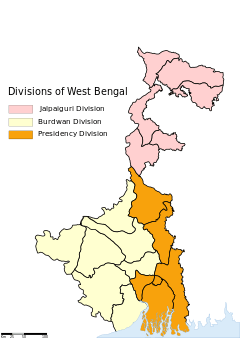Sushil Kumar Dhara
| Sushil Kumar Dhara | |
|---|---|
| Born |
2 March 1911 Tikarampur, Midnapore |
| Died |
28 January 2011 (aged 99) Mahishadal, Midnapore |
| Occupation | Freedom Fighter, Elected Official |
| Nationality | Indian |
Sushil Kumar Dhara (Bengali: সুশীল কুমার ধাড়া) (2 March 1911 – 28 January 2011) was a revolutionary in British India and a political leader after Indian independence in 1947.
Dhara was born on 2 March 1911 in Tikarampur (near Tamluk) in Mahisadal in the present Purba Medinipur district. He was involved in political activities from his school days.[1] Dhara was entrusted the portfolios of war and home in Tamralipta Jatiya Sarkar (Tamralipta National Government) formed during the `42 movement. He also commanded Vidyut Bahini (the lightning brigade) of the parallel Government in Tamluk.[2] In 1944 the government of British India declared a reward of ten thousand Rupees for Dhara's apprehension, dead or alive. He spent 12 years 4 months in jails in British India.[1]
He won several elections after independence of India, including the Mahisadal seat to West Bengal state assembly in 1962, 1967, 1969 and 1971.[3] He had served as minister in the state government.[1]
Dhara was elected to the Lok Sabha in 1977 from Tamluk constituency.[4] In the 1980s he moved away from active politics and involved himself in social work.[1] He is the founder of Tajpur High school(Year 1960), Rajarampur Nimno Buniyadi Prathomick vidyalaya, Matri Sadan(Hospital) and Khadi Gramodoyak etc. All these Institutions are located near Mahishadal. In the year 1967 Narayan Chandra Ghosh, Abdul Mannan and Banibikash Mallick met Bangla Congress leaders for requesting Ajoy Mukherjee to contest against Prafulla Chandra Sen another Gandhian leader and chief minister of West Bengal. Sushil Kumar Dhara visited Arambagh and inspired students there with his commander image of "Vidyut Bahini" (the lightning Brigade) of the parallel Government in Tamluk in colonial times and organise people there infavour of joy Mukherjee who defeated Prafulla Chandra Sen at Arambagh assembly constituency and became chief minister of West Bengal after Prafulla Chandra Sen. Architect of Ajoy Mukherjee's victory at Arambagh was Narayan Ch Ghosh the then students leader at Arambagh. Sushil Kumar Dhara had published a booklet entitled 'Ken Banaya'(Why flood)written by Narayan Ch Ghosh and to inspire young writer Sushil Kumar Dhara distributed that book in the areas of Hooghly and Midnapore. That book was most popular one after the report of Mansing Committee and writings of Kapil Bhattacharaya, Radhanath Ghosh. Ajoy Mukherjee, his long term associates, with some of his closed colleagues, viz. Pranob Mukherjee etc., joined Indian National Congress leaving Sushil Dhara. After joining INC Ajoy Mukherjee was offered ministerial post at Center by Indira Gandhi- the then Prime Minister of India, but Ajoy Mukherjee saying his age and health condition had pushed Pranab Mukherjee. Pranab Mukherjee became State Minister in the Indian Cabinet. It is known that later Sushil Dhara had no connection with Pranab Mukherjee. Sahid Smriti Sharak at Nimtori is his most notable contribution.
Sushil Kumar Dahra died on 28 January 2011 in Mahishadal, only 5 weeks before he was to turn 100.
References
- 1 2 3 4 Kolkatar Karcha, Ananda Bazar Patrika, print edition, in Bengali, 17 August 2009.
- ↑ "Sushil Dhara: Dreams of '42 Service in '90's". janasamachar.net. Archived from the original on 3 May 2007. Retrieved 2009-08-22.
- ↑ "Statistical Reports of Assembly Elections". General Election Results and Statistics. Election Commission of India. Retrieved 2011-01-28.
- ↑ "30 – Tamluk Parliamentary Constituency, West Bengal". Partywise Comparison since 1977. Election Commission of India. Retrieved 2010-01-28.
